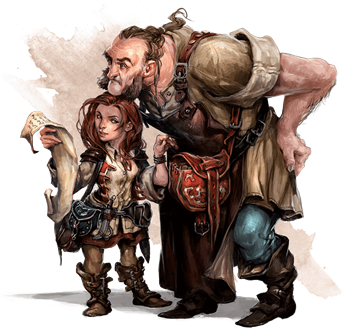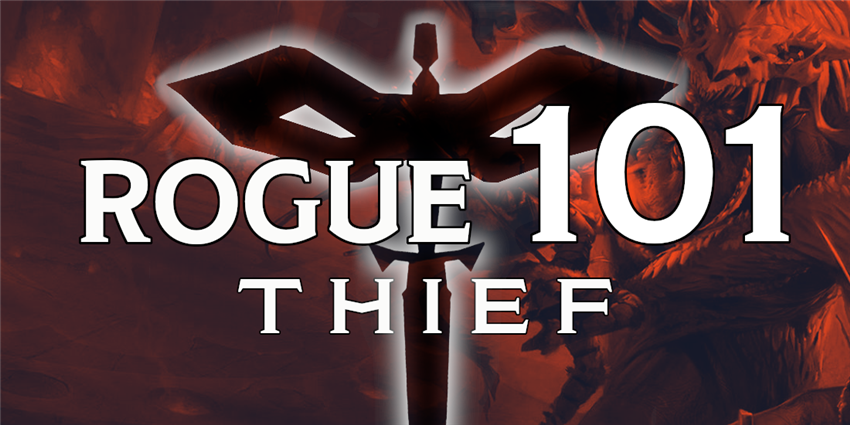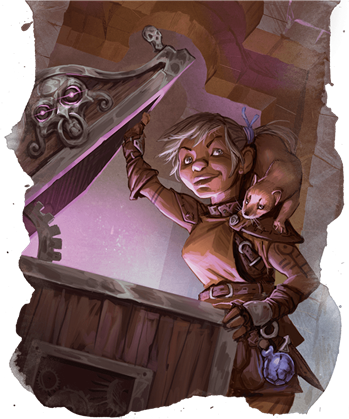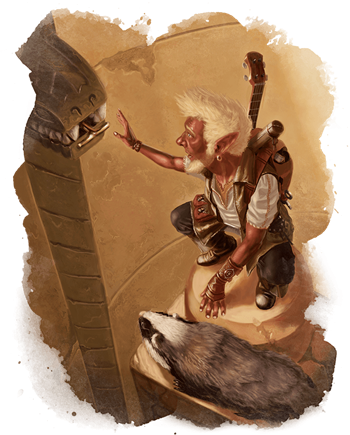 Class is in session! It’s time to get sneaky with the roguish archetype known simply as the Thief. If you want to scale buildings with ease, pick locks with lightning speed, and all but dissolve into shadows while sneaking.
Class is in session! It’s time to get sneaky with the roguish archetype known simply as the Thief. If you want to scale buildings with ease, pick locks with lightning speed, and all but dissolve into shadows while sneaking.
Story of the Thief
“A burglar, you call me?” said the halfling, studying the contract before her. “Ha! Burglar, indeed. I’ve read the same stories you have, heard the same fool notion of “burgling” your dragon problem away. Do you know what I have to say to that?”
And she stopped for a moment, and appraised the cadre of dwarves before her. She thought of the grand reward they were offering her—a veritable dragon’s hoard. She thought of the danger, of course, but quickly dismissed that troublesome notion from her mind. Then, her imagination concocted a scene. There she was, within the dragon’s lair, surrounded by a sea of gold dotted with such treasures that would make even Mammon weep jealous tears. She thought of how easily she could betray the rag-tag assembly of artisans and laborers that surrounded her. How easily she could grab a priceless trinket or three and vanish into the night.
A smile crossed the thief’s lips, and she leaned in towards the stern countenance of the dwarves’ leader.
“I’d say… I’m in.”
Thief Features
The rogue class has a strong class identity, meaning that most of your best class features will come from the rogue class itself, not from your subclass. Nevertheless, it’s important to consider what benefits your subclass will give you further down the line, as the rogue gains subclass features skew late—you gain your first feature at 3rd, but then must wait until 9th for your next, with your final two features eventually coming at 13th and 17th level.
You can read all of the Thief features for free in the D&D Basic Rules. In summary, your subclass features allow you to:
- Perform sleight of hand, pick locks, use items, or disarm traps in the blink of an eye.
- Rapidly climb to great heights or make long jumps—try climbing to the top of a building and jumping from rooftop to rooftop!
- Sneak exceptionally well while moving slowly.
- Improvise with magical items, bypassing any requirements of class, race, or level.
- Take two turns in the first round of all combats.

Benefits of Playing a Thief
The Thief archetype is the rogue’s most iconic incarnation, and all of its features are in service to enhancing your existing roguish talents. Your skills as a pickpocket, locksmith, and trap-buster all improve while playing this archetype, as do your Assassin’s Creed-style acrobatic talents. All of these skills make you a better rogue, but the real strength of the Thief archetype is how smoothly it introduces new players to Dungeons and Dragons.
The first subclass features the rogue gets are simple, passive improvements to things they can already do. It increases the length of your long jump, lets you climb twice as fast, or do certain roguish activities like pick a lock as a bonus action, rather than as an action. When you reach the middle levels of play, your abilities are still just improvements to your basic skills, but now you need to take deliberate action in order to gain their benefits—for instance, you need to choose to move only half your speed on your turn if you want to use Supreme Sneak.
Then, finally, when you reach the high levels, you get access to abilities that encourage you to scheme and strategize. What unusual synergies can you create with magic items that you’re not intended to be able to use? What can you do in the first turn of combat if you have two turns instead of one? The Thief archetype has successfully trained you to be a clever and tactical D&D player, starting with simple and easy-to-master passive traits, and eventually graduating to in-depth and strategic features. With this in mind, I highly recommend any DM running a game for new players encourage at least one of their players to play as a rogue of the Thief archetype.
Drawbacks of Playing a Thief
One drawback of this learn-by-playing approach is that it leaves veteran players in the lurch for about the first ten levels of play. The Thief isn’t a mechanically bad archetype—it’s quite powerful within its niche—but it’s not exactly bursting with choices. Spellcasters like clerics and wizards already have access to a wide variety of spells by 3rd level, whereas Thief archetype rogues only have passive improvements to their existing traits.
If you can stick it out to later levels, your ability to make active and tactical decisions increases immensely, but how many campaigns really last ‘til 13th level, let alone 17th? If you want to make decisions and feel like you’re actively playing a quick-thinking scoundrel, then there are other roguish archetypes that will get you there instead. The deadly and secretive Assassin, from the Player’s Handbook, as well as the Mastermind and Swashbuckler, both from Xanathar’s Guide to Everything, spring immediately to mind.
Suggested Build
 If you’re playing a rogue from 1st level, bear in mind that you won’t be able to choose your archetype until 3rd level. Use this time to figure out what role you want to fill in your party—a sneaky, independent burglar that supports your party both in and out of fights? Or perhaps you want to be a shadowy, damage-dealing assassin? Or maybe a magic-wielding illusionist and trickster? No matter which path you wish to pursue, you’ll want to focus on being a good rogue first and foremost.
If you’re playing a rogue from 1st level, bear in mind that you won’t be able to choose your archetype until 3rd level. Use this time to figure out what role you want to fill in your party—a sneaky, independent burglar that supports your party both in and out of fights? Or perhaps you want to be a shadowy, damage-dealing assassin? Or maybe a magic-wielding illusionist and trickster? No matter which path you wish to pursue, you’ll want to focus on being a good rogue first and foremost.
You should choose a race that improves your Dexterity score and either your Wisdom or Intelligence scores. Dexterity is important for rogues because it helps you hide, open locks, perform feats of sleight of hand, and wield both ranged and finesse weapons. Wisdom helps rogues in perceiving danger and breaking out of enchantments, while Intelligence is vital for investigating doors and other objects for locks and traps. High elves and wood elves make excellent rogues, as all elves gain a large bonus to Dexterity, and these subraces give a smaller bonus to either Wisdom or Intelligence. Lightfoot (and to a lesser extent, Stout) halflings make for nimble and perceptive rogues—apt, given the original fantasy burglar was none other than the halfing known as Bilbo Baggins.
Ability scores like Strength and Charisma are of little use to you, but Constitution is at least somewhat important to all characters. Fortunately, you’ll be using your Cunning Action to weave in and out of combat most of the time, but a little bit of extra Constitution couldn’t hurt. Having a few more hit points than the average rogue will help you take a hit on those rare occasions when you’re unable to flee to safety in the middle of a fight. As usual, your character’s background is up to you. You can come up with all sorts of interesting stories and oddball characters by pairing unlikely backgrounds like Acolyte or Sage with the typically sly and shadowy rogue class, or go for a more standard choice, like Urchin or Criminal.
Choose EQUIPMENT instead of GOLD at the end of character creation. If you plan on fighting in close combat as a thief, choose one shortsword now, and… one shortsword instead of a shortbow! You can dual wield these shortswords, giving you more opportunities to hit an enemy and deal that all-important Sneak Attack damage on your turn. If you plan on mostly staying out of harm’s way and only fighting from range, then take a rapier and a shortbow. A burglar’s pack is all but essential for you, too.
Expertise
An important part of a Thief’s build comes into play at 1st level, when you gain the Expertise feature. Simply put, choose two skill proficiencies or with thieves’ tools. From here on out, you add TWICE your proficiency bonus to any check made with those skills or tools, instead of adding it just once. The feature explicitly calls out thieves’ tools, as if to signal that gaining expertise with them is incredibly important. It is. As a Thief, you live to unlock locks and disarm traps, and being a master with thieves’ tools is the best way to do so.
As a sneaky sort of character, gaining expertise in the Stealth skill is vitally important. When you get to gain expertise in two more skills at 6th level, however, you should feel free to be a little bit more flavorful with your choices. Consider what skills has your character really invested in over the course of their adventures, and gain expertise in the ones that really define your experiences!
Feats
 As a rogue, you’ll probably want to use your Ability Score Improvements (which you gain at 4th level and every four levels thereafter) to max out your Dexterity score as soon as possible. However, if you reach 4th level and feel that you’re basically as sneaky as you need to be for now, choosing a feat can help give you some additional tactical options that the Thief archetype lacks at early levels. Some good feats for you include:
As a rogue, you’ll probably want to use your Ability Score Improvements (which you gain at 4th level and every four levels thereafter) to max out your Dexterity score as soon as possible. However, if you reach 4th level and feel that you’re basically as sneaky as you need to be for now, choosing a feat can help give you some additional tactical options that the Thief archetype lacks at early levels. Some good feats for you include:
Crossbow Expert allows you to fight from range like a master, dexterously wielding a hand crossbow in one hand a blade in the other, and ignoring that pesky Sneak Attack-cancelling disadvantage you get when shooting while in melee range of a hostile creature.
The Healer feat allows you to get serious mileage out of a healer’s kit, and it just so happens that your Fast Hands trait lets you use an item like a healer’s kit as a bonus action!
Ritual Caster gets you easy access to the find familiar spell. Having a magical little partner in crime is an awesome character choice, and it’s also an easy way to gain advantage—and thus, Sneak Attack—on every turn.
Skulker is just an all-around good feat for any stealthy character, and there’s no one stealthier than a Thief.
If you want more advice for building a rogue, check out Rogue 101. Have you ever played a Thief archetype rogue? What advice would you give to players that want to play this subclass?
 James Haeck is the lead writer for D&D Beyond, the co-author of Waterdeep: Dragon Heist and the Critical Role Tal'Dorei Campaign Setting, the DM of Worlds Apart, and a freelance writer for Wizards of the Coast, the D&D Adventurers League, and Kobold Press. He lives in Seattle, Washington with his partner Hannah and their animal companions Mei and Marzipan. You can find him wasting time on Twitter at @jamesjhaeck.
James Haeck is the lead writer for D&D Beyond, the co-author of Waterdeep: Dragon Heist and the Critical Role Tal'Dorei Campaign Setting, the DM of Worlds Apart, and a freelance writer for Wizards of the Coast, the D&D Adventurers League, and Kobold Press. He lives in Seattle, Washington with his partner Hannah and their animal companions Mei and Marzipan. You can find him wasting time on Twitter at @jamesjhaeck.








-
View User Profile
-
Send Message
Posted Jul 19, 2019I was first! Great article. I love playing thieves.
-
View User Profile
-
Send Message
Posted Jul 19, 2019beatiful
-
View User Profile
-
Send Message
Posted Jul 19, 2019Crossbow expert has to be one of my all time favorite feats in the game. It's so versatile and powerful for crossbows
-
View User Profile
-
Send Message
Posted Jul 19, 2019Man, James, you crank out the content! Great job. Gods bless DDB.
-
View User Profile
-
Send Message
Posted Jul 19, 2019-
View User Profile
-
Send Message
Posted Jul 19, 2019Thief has become my favorite subclass for a huge reason, and that's "Fast Hands".
It's mentioned here briefly with the "Healer" feat, which is amazing for a combat medic-type character.
But when you realize the sheer variety of poisons, explosives, and items a Thief-Rogue can utilize with "Fast Hands", it can get hilarious what you can do...
Track your target. Use "Fast Hands" to plant an explosive on them...say, "Alchemical Fire Flask" or "Dynamite"...and initiate combat when he's nice and close to his buddies. Then shoot the explosive where you know you placed it. Kaboom. Depending on the interpretation, you can fling grenades with "Fast Hands" as a bonus action.
"Fast Hands" a smoke grenade for a quick getaway or cover.
Use "Fast Hands" to add a knockout toxin or poison to your crossbow or blowgun...sneak up to a target, take aim and fire! If you're lucky, they don't make the save and are knocked unconscious! You're officially one of the few classes that can "effectively" make a sleep dart! (Note: proficiency with Poisoners Kit let's you add proficiency to the Constitution save they must make!)
"Fast Hands" a hunting trap and keep a particularly nasty enemy within a certain area, and pick them off with a crossbow or dagger from a safe distance.
Use "Fast Hands" to apply a set of manacles to an enemy....for added humor, apply the manacles to two different enemies: One guys ankle, another guy's wrist. Kudos if you manage to sneak and manacle more than two guys while they're sleeping...point and laugh as they stumble and trip over each other. "Dimensional Shackles" for spellcasters, or "Iron Band Balls" for more sturdy foes.
"Fast Hands" a grappling hook and become Batman...you add verticality to any place you can hook. See if you can use proficiency with "Tinkers Tools" to make an automatic grappling hook...then you can be Spiderman!
As a Thief, you are a master of items and gadgets the same way a Wizard is a master of spells...you just need the resources to find.
-
View User Profile
-
Send Message
Posted Jul 19, 2019My DM got super mad at me for breaking the game once by playing a rogue, though I wasn't a thief. I played a kobold arcane trickster who had learned find familiar, and thus used pack tactics to sneak attack every turn. Eventually I abandoned her because I hadn't thought the character's backstory out enough, but it was crazy fun to be a massive damage-output.
Anyway, I liked your reference to the ritual caster feat. One of my favorites.
In the question of "Have you ever played a thief?" I think you meant rogue, not ranger.
Thanks. These articles have been great.
-
View User Profile
-
Send Message
Posted Jul 19, 2019Dumb question, but is the:
Is that the 17th Level Thieves Reflexes? Or have I been playing my character all wrong?
-
View User Profile
-
Send Message
Posted Jul 19, 2019Grammar snag in the introductory paragraph: " If you want to scale buildings with ease, pick locks with lightning speed, and all but dissolve into shadows while sneaking." This sentence has no second half to provide reason for the "if" at the beginning. It seems like either half of it was left out accidentally (like perhaps "... then this is the archetype for you.") or the "if" and sentence structure is a remnant of a former version of this article. Either way, could use a little attention c:
-
View User Profile
-
Send Message
Posted Jul 19, 2019Also, the closing statement says "Have you ever played Thief archetype ranger? ?" Emphasis mine. It mislabels the Thief as a Ranger archetype, and leaves out an "a" before the word "Thief".
-
View User Profile
-
Send Message
Posted Jul 19, 2019Brilliant article, and good point about the Healer's Kit. All the times I've tried to work out how to put a medic character into 5e, I've never noticed that one.
-
View User Profile
-
Send Message
Posted Jul 19, 2019@Katharsis
-While I understand your point, Fast Hands isn't quite that useless. If you move first, for example, you can take the guardsman's sword before he can draw it, or even the wizard's component pouch, or the cleric's holy symbol! Plus, while it doesn't work on Magic Items (sadly, also not called out in the class itself), it does work on all sorts of things...
@Tony1Adobe
-As this fine human has described! I really like all these crazy uses, and I love the grappling hook idea! Should note that any alchemical item that requires some kind of Attack is not applicable, but anything that's just chucked at a spot should be.
@FC_WILL
-That's the 17th level ability indeed; it actually looks really powerful, especially if you can rack up a mad Initiative (which, yes, you can; you're a Rogue). Plus, well, a rogue should (as a general rule) always be trying to start off with a Surprise Round anyway, and you have the tools to do that very well. That means you can get three turns off before they even notice that they've taken... oooh... at that level... 27d6 ouchies of Sneak Attack damage. Needless to say, not bad. You've made the Barbarian cry though, which isn't nice, but then again you got to seventeenth level as a Rogue. Being not nice is what you're good at. Most things are what you're good at.
-
View User Profile
-
Send Message
Posted Jul 19, 2019I once built a character around this. It worked pretty well
-
View User Profile
-
Send Message
Posted Jul 19, 2019C'mon, the strongest subclass is Assassin. Hands down. Nobody else in the game can lay down multiple critical hits in the first round of combat. From there it's a race for second.
Try something like a half-orc Brute/Gloom/Assassin and experience the fun of laying down more than half a dozen critical hits and hundreds of points of damage in a single round.
Alternatively, try an Assassin 17/Gunslinger 3, and hit your foes with a grit-amped Bad News, eg [(8d12+18d6 + mod) x 2] (save for half).
Mandatory catchphrase: "THIS is my BOOMSTICK."
-
View User Profile
-
Send Message
Posted Jul 19, 2019This isn't just depending on interpretation, it's RAW. (My Thief characters have also done most of the other things that you mentioned in your post)
-
View User Profile
-
Send Message
Posted Jul 19, 2019There is apparently some contestation on some semi-contradictory rules...but at the end of it all, it seems to win out in favor.
-
View User Profile
-
Send Message
Posted Jul 19, 2019Just want to point out that RAW you cannot dual weild hand crossbows as you mentioned under Crossbow Expert, because they have the ammunition property, which specifically states that you need a free hand to draw a piece of ammunition for a one handed weapon.
Also, for any aspiring thieves out there, if you are feeling saucy, try a 2 level dip into fighter in your early levels for some interesting tactical options. Action surge is great for pushing you beyond your limits and accents your versatility very well.
-
View User Profile
-
Send Message
Posted Jul 19, 2019Is your story section inspired by the beginning of The Hobbit? :)
-
View User Profile
-
Send Message
Posted Jul 19, 2019Indeed. There's also no benefit to dual-wielding them - you can use the same hand crossbow for your Attack action and your bonus action anyway.
-
View User Profile
-
Send Message
Posted Jul 19, 2019It's in the DMG's description of magic items: https://www.dndbeyond.com/sources/dmg/treasure#ActivatinganItem